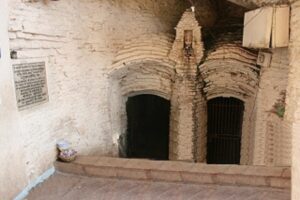
Udayagiri Caves are a group of rock – cut cave sanctuaries, carved into a sandstone hill that stand, sentinel like, on the horizon. Situated in Sonpura and Udaygiri villages of Vidisha district of Madhya Pradesh, these are the finest example of classical gupta arts. Literarily means hill of sunrise, Udayagiri was mentioned as Kumari Parvat in Hathigumpha inscription.
An inscription in one of these, states that it were carved during the reign of Changragupta II (382 -401AD), thus it is estimated that these were carved during 4th to 5th A.D. The caves represents all the distinctive features of Classical Gupta art – its simplicity of expression, the beautifully moulded capitals, the treatment of the intercolumniation, the design of the entranceway and the system of continuing the architrave as a string course round the structure, religious virtuosity etc.
There are about twenty rock cut caves carved into an outcrop of sandstone and most are just niches however some form columned temples. These caves have been numbered according to the sequence in which they were excavated. In Caves four, six and nineteen, one can observe that the shrines become larger and more ornate and cells appear more spacious. Cave 1, which has a frontage adapted out of a natural ledge of rock, thus forming both the roof of the cella and its portico. The row of four pillars bears the vase and foliage pattern. Characterized by richly carved facades and doorways, the shrines are progressively more spacious and more ornate.
Dating back to early 5th century, Cave no 5 depicts Vishnu in a massive carving as Varaha (Boar) incarnation. It is also called as Varha Gufa. The sculpture is holding the earth goddess Prithvi aloft upon one tusk. Yet another large sculpture is of the reclining Vishnu. Rows of Sages, divinities and two male musicians can be seen at the back and on the sides of the panels, images of river goddesses Ganga and Yamuna with figures of attendants. It is claimed that these scenes represents the unification of northern India by the Guptas.
Taken as a whole, this stupendous group is a rich representation of the vitality and strength of Gupta art and architecture.

Cave 4 Known as Bina Cave, a stage in process can be seen in cave number four. An impressive Shiva Lingam is there inside Cave 4 over a rock-cut platform and one can access the cave through some delicate floral scrolls. Square moulded rocks are places near the door frames, and the cave is surrounded by two rock carved pillars and two ‘dwara-palas’ or door guardians.
Cave 6 has a doorway ornately carved with figures of river goddesses standing on makaras, aquatic monsters, and two pillars with fluted capitals. On the walls, there are elaborately carved sculpture panels of deities on either side, depicting guardians and images of Vishnu as Varaha and Durga. There is also an inscription of Chandragupta II above.

Cave no. 9 is famous for its large cella and massive, 8 feet high pillars, its long portico and pillared hall. Throughout, there is evidence that the master craftsmen of Besnagar practiced their art with skill and artistry under the Guptas, four centuries later.

Cave no.13 is an open cave of 12 ft long, remarkable for its large rock-cut sculpture of Lord Sheshashayi Vishnu.
Dating back to mid -5th century Cave19 shows distinct features of architectural value. The cave is notable for its figures of Ganga and Yamuna with small figures and imposing patterns. A mural depicting, the myth of gods and demons churning the Ocean of Milk to obtain amrita (water of immortal life), is carved over the lintel. A number of lingams and a Nandi image can be seen, which indicate that it is a Shaivite cave. There are four columns in the sanctuary which have square shafts. The roof is supported by four massive pillars, 8 feet high and 1 foot 7 inches square, also hewn out of the rock. They have richly-ornamented capitals, but instead of the usual turnovers at the four corners, they have four horned and winged animals standing upright on their hind legs, and touching their mouths with their forefeet.
Source:
http://tourism.webindia123.com/tourism/monuments/caves/udaygiri/index.htm


